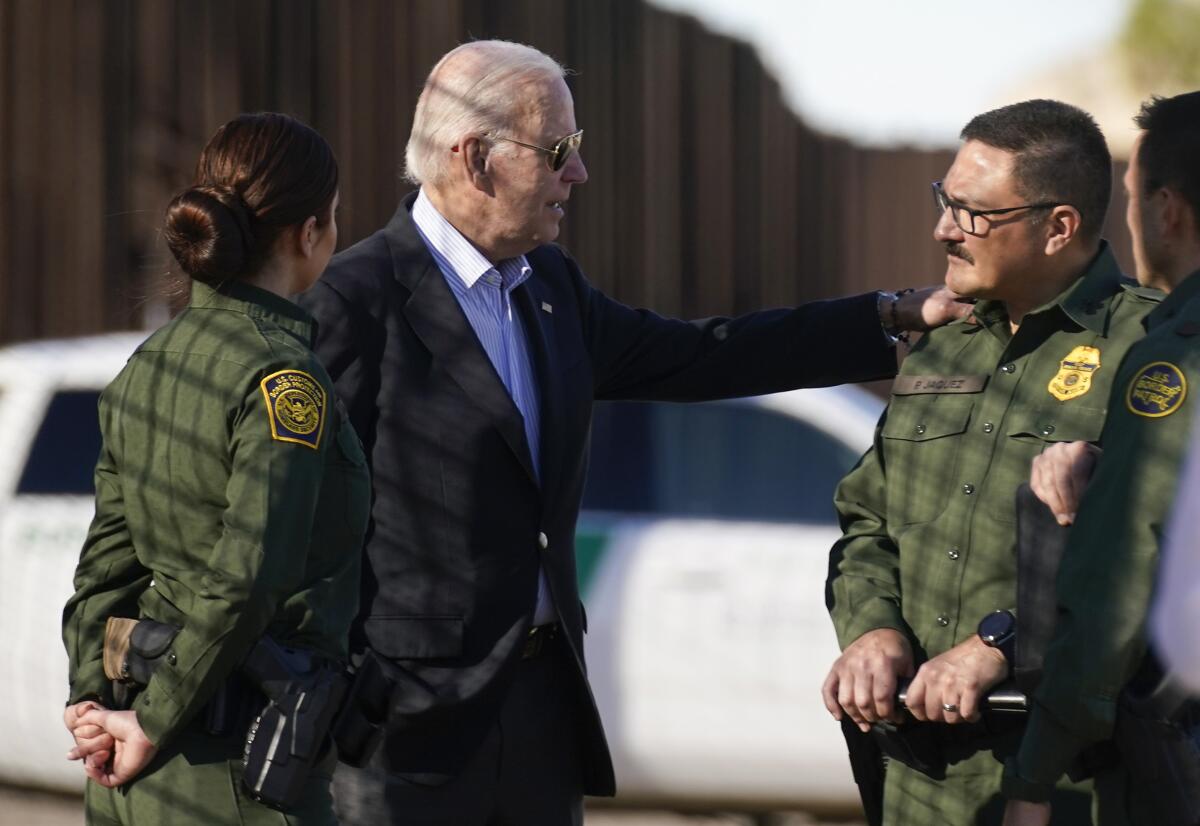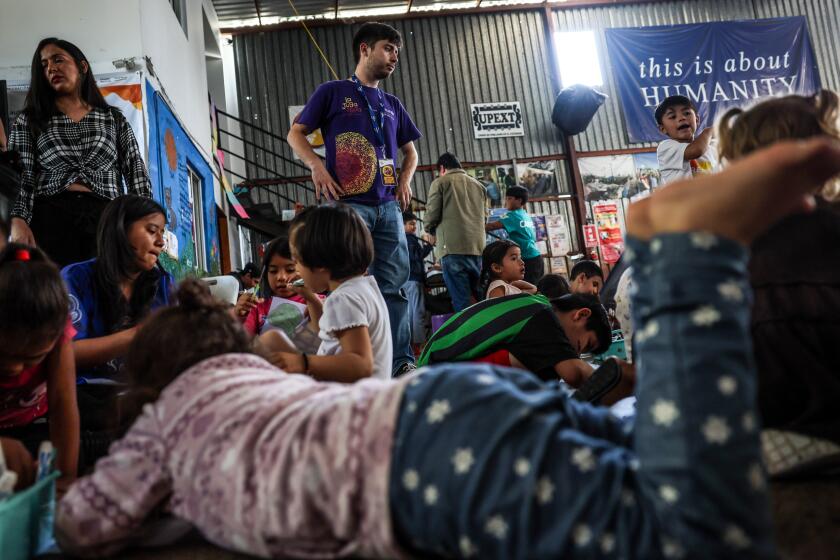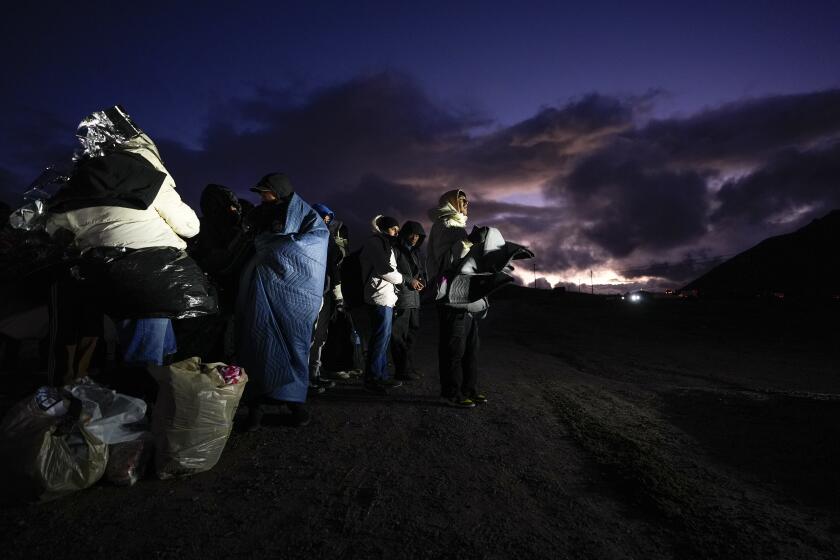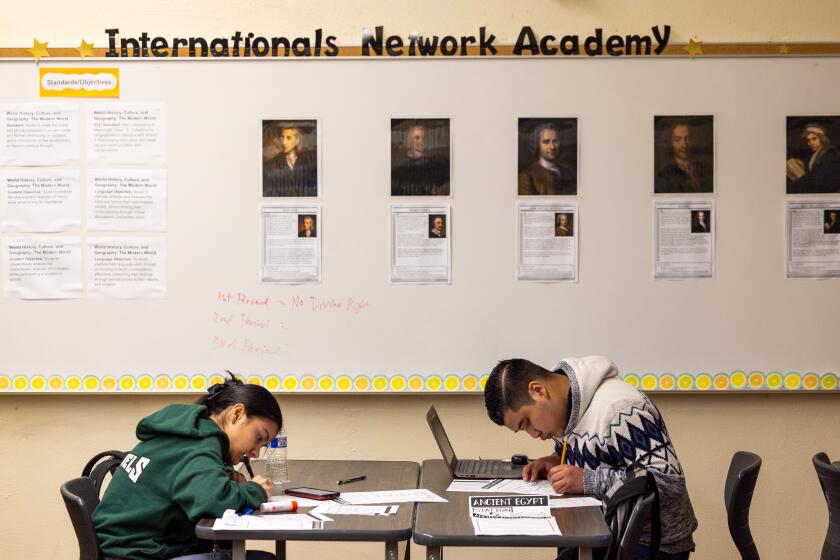Opinion: Why Biden’s new border plan is a terrible idea

- Share via
Following months of rumors, on Tuesday the Biden administration unveiled an executive order designed to shut down the border to people seeking asylum, as well as a rule to implement it. The rule took effect at 12:01 a.m. ET on Wednesday, marking the administration’s most drastic ploy to restrict asylum yet.
With limited exceptions, the rule closes the border to people seeking asylum when crossings exceed a daily average of 2,500 for seven consecutive days, and only reopens when there has been a sustained decrease in arrivals. For more than three years, crossings have exceeded that threshold every single week, meaning restrictions will loom over the foreseeable future.
During these shutdowns, people fleeing persecution are ineligible for asylum and have only a slim chance at accessing two limited forms of protection — withholding of removal and Convention Against Torture relief — if they can meet a far higher standard than that required for asylum. But to even have the chance to obtain these forms of relief, asylum seekers will be required to proactively express their fear at arrival and prove the strength of their claims — most likely without the assistance of an attorney or the opportunity to gather evidence.
How President Biden’s executive order limiting asylum is playing out on the California-Mexico border.
Withholding and Convention Against Torture protections only prevent the person from being returned to their home country. Unlike asylum, they do not lead to likely lawful permanent resident status and then citizenship, and they do not allow an individual to bring their spouse or children who may have been left behind in the home country — consigning families to separation. Anyone who seeks protection and is denied may be subject to a five-year bar to reentry and face a potential criminal prosecution upon attempted return.
Putting aside the punitive nature of the new rule, if it has the desired effect of temporarily reducing crossings, it is not hard to imagine the chaos a swinging door of asylum will cause at the border. An asylum shutdown will force people to congregate in northern Mexico, where many will fall prey to violence. Thousands of individuals who attempt to enter when the border is officially closed will be subject to processing and removal by immigration authorities, and it’s not at all clear that the agency has the means to return them all to their home countries, or whether the U.S. will negotiate with Mexico to accept those being expelled.
Biden’s executive order met swift condemnation from rights groups, the UN Refugee Agency and progressive lawmakers who agreed: It is not just a harsh rightward shift on immigration. It contravenes both U.S. law and international norms, which prohibit the return of refugees to countries where they face persecution or torture.
Should migrants ‘get in line and wait their turn’? What if there is no line? What if we changed that?
The move is the latest in a series of restrictive policies ripped from the pages of Donald Trump and Stephen Miller’s immigration playbook. The administration’s new rule relies on the same legal authority underpinning the Muslim Ban, and is reminiscent of Trump’s asylum ban that was challenged and struck down by the courts. Civil rights groups, including the ACLU, have pledged to challenge this policy too.
President Biden has touted his executive order as necessary to “restore order” and “gain control” of the border, despite crossings plummeting in recent months. His Department of Homeland Security claims that such restrictions will “deter irregular migration” at a time of political backlash against a narrative of chaos at the border.
But time and time again, we have seen how crackdowns on asylum only exacerbate chaos and dysfunction at the border, while doing nothing to “deter” people who are fleeing for their lives, or to address the root causes of forced migration. People seeking asylum at the U.S. border come from countries with widespread human rights violations and high levels of violence, which combined with climate change and economic under-development are strong push factors for migration. When people see no path to survival at home, draconian restrictions will only force them to pursue more perilous crossings.
To recognize immigrants’ tax contributions and spending power, California has pioneered programs that should be imitated and expanded.
On Tuesday Biden stated that his new rule will merely close the door to those who “choose” not to avail themselves of other “legal pathways.” He seems to forget that our refugee laws, unanimously passed by Congress more than 40 years ago, expressly state that anyone arriving at our border — even if they are not at a port of entry — has the right to seek asylum. So asylum seekers are availing themselves of legal pathways.
Biden came into office with a promise to restore “the soul of our nation” and our country’s “historic role” as a leader in refugee protection. Unfortunately, he has abandoned this principled commitment based on the false belief that his political survival largely depends on being tough on immigration.
Smart policies and the allocation of adequate resources would allow the U.S. to accept and fairly process asylum seekers in a timely fashion. This would not only be good policy, but good politics. Most voters — and the overwhelming majority of the president’s base — support a fair and legal asylum system and reject exclusionary, Trump-style policies.
A particular irony in the timing here is that Biden announced the executive order within days of the 85th anniversary of the iconic voyage of the St. Louis, a ship that sailed from Germany with Jewish refugees fleeing Nazi Germany. They were turned away by both Cuba and the United States; the ship returned to Europe, where about a third of the passengers perished. The St. Louis is often invoked as a seminal event that led to the creation of our current global refugee protection system. There couldn’t be a better time to raise its memory as an example of what can happen when refugees are turned away.
Karen Musalo is a law professor and the founding director of the Center for Gender and Refugee Studies at UC Law San Francisco.
More to Read
A cure for the common opinion
Get thought-provoking perspectives with our weekly newsletter.
You may occasionally receive promotional content from the Los Angeles Times.













